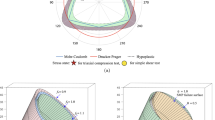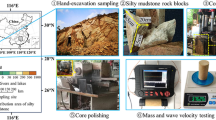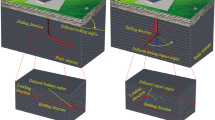Abstract
Understanding and accurately modeling the creep behavior of rock salt is of great interest for its relevance to geological storage of nuclear wastes, oil, and gases. Many experimental studies on the creep of salt samples are performed at a deviatoric stress above 5 MPa. The creep rates at smaller stress levels are usually estimated by extrapolating from data at higher stress levels. However, recent low-stress creep tests conducted at below 1 MPa suggest that such extrapolation can significantly underestimate the creep rate of rock salt, as the controlling micro-mechanisms are very different in low- and high-stress regimes. Meanwhile, field observations suggest that salt creep is accelerated under higher ambient relative humidity (i.e., the so-called Joffe effect). The effect of humidity on salt creep in the pressure-solution dominating low-stress regime is even less understood at present. In this context, we conducted a series of long-term creep tests at intermediate–low uniaxial stresses of 1, 3, and 5 MPa on Avery Island salt samples. In order to quantify the effect of moisture on salt creep, a combined triaxial cell and air circulation system is designed to permit control over the environmental humidity. Three relative humidity levels (33%, 55% and 77%) are selected and are achieved through the vapor equilibrium technique. Our study confirmed that the creep rate at low stress level is indeed higher than those extrapolated from high-stress creep tests. For the same deviatoric stress, higher ambient humidity produces faster steady-state creep rate of salt samples. Finally, a modified creep law that incorporates the humidity dependency is proposed and validated against the new experimental data.
Highlights
-
The influence of ambient humidity on creep behavior of rock salt at intermediate–low stress regime was experimentally investigated.
-
A novel experimental setup was developed to provide stable humidity- and stress-control during long-term uniaxial creep tests.
-
Humidity-dependent scaling functions inspired by existing water retention and adsorption models were introduced in the steady-state creep model for rock salt.








Similar content being viewed by others
Data Avaliability
The data that support the findings of this study are available on request from the authors.
References
Baumann TS, Bérest P, Brouard B, ter Braack M, den Hartogh M, Kaus B, Klaver J, Oonk P, Popov A, Schmatz J and Urai JL (2022) CCC-integrated multiscale study of salt cavern abandonment in the Netherlands. The Mechanical Behavior of Salt X, pp. 567–576
Bérest P, Blum P, Charpentier J, Gharbi H, Vales F (2005) Very slow creep tests on rock samples. Int J Rock Mech Min Sci 42:569–576
Bérest P, Beraud J, Gharbi H, Brouard B, DeVries K (2015) A very slow creep test on an Avery Island salt sample. Rock Mech Rock Eng 48:2591–2602
Bérest P, Gharbi H, Brouard B, Bruckner D, DeVries K, Hevin G, Hofer G, Spiers C, Urai J (2019) Very slow creep tests on salt samples. Rock Mech Rock Eng 52:2917–2934
Birkholzer J, Houseworth J, Tsang CF (2012) Geologic disposal of high-level radioactive waste: status, key issues, and trends. Annu Rev Environ Resour 37:79–106
Burnauer S, Emmett PH, Teller E (1938) Adsorption of gases in multimolecular layers. J Am Chem Soc 60(2):309–319
Butt HJ, Graf K, Kappl M (2013) Physics and chemistry of interfaces. Wiley, New York
Carter NL, Hansen FD (1983) Creep of rock salt. Tectonophysics 92(4):275–333
Chan KS, Bodner SR, Munson DE (1998) Recovery and healing of damage in WIPP salt. Int J Damage Mech 7(2):143–166
Chen S, Hiraga T, Kohlstedt DL (2006) Water weakening of clinopyroxene in the dislocation creep regime. J Geophys Res 111:B08203
Chopra PN, Paterson MS (1984) The role of water in the deformation of dunite. J Geophys Res 89(B9):7861–7876
Cornet JS, Dabrowski M, Schmid DW (2017) Long-term cavity closure in non-linear rocks. Geo J Int 210:1231–1243
Cornet JS, Dabrowski M, Schmid DW (2018) Long-term creep closure of slat cavities. Int J Rock Mech Min Sci 103:96–106
Cristescu ND, Hunsche U (1998) Time effects in rock mechanics. Series: materials, modelling and computation. Wiley, Chichester
Espitia J, Caicedo B, Vallejo L (2019) Comparison of the uniaxial compressive strength of the Belencito claystone under stress control and suction control paths. Rock Mech Rock Eng 52(1):19–34
Ewing RC, Whittleston RA, Yardley BW (2016) Geological disposal of nuclear waste: a primer. Elements 12(4):233–237
Gelb L, Gubbins K (1998) Characterization of porous glasses: simulation models, adsorption isotherms, and the Brunauer–Emmett–Teller analysis method. Langmuir 14:2097–2111
Greenspan L (1997) Humidity fixed points of binary saturated aqueous solutions. J Res Natl Bureau Stand 81:89
Gunther R, Salzer K, Popp T, Ludeling C (2015) Steady-state creep of rock salt: improved approaches for lab determination and modelling. Rock Mech Rock Eng 48:2603–2613
Hunsche U, Hampel A (1999) Rock salt—the mechanical properties of the host rock material for a radioactive waste repository. Eng Geol 52(3):271–291
Hunsche U, Schultze O (1996) Effect of humidity and confining pressure on creep of rock salt. In: Hardy HR Jr, Langer M (eds) Proceedings of the third conference on the mechanical behavior of slat. Trans Tech Publications, Clausthal, Germany, pp 237–248
Joffe A, Kirpitschewa M, Lewitsky M (1924) Deformation and strength of crystals. Z Phys 22:286
Lau J, Chandler N (2004) Innovative laboratory testing. Int J Rock Mech Min Sci 1(8):1427–1445
Li S, Urai J (2016) Rheology of rock salt for salt tectonics modeling. Pet Sci 13:712–724
Mansouri H, Ajalloeian R (2018) Mechanical behvaior of salt rock under uniaxial compression and creep tests. Int J Rock Mech Min Sci 220:19–27
Martin LB, Rutqvist J, Birkholzer JT (2015) Long-term modeling of the thermal–hydraulic–mechanical response of a generic salt repository for heat-generating nuclear waste. Eng Geol 193:198–211
Parker E, Pask J, Washburn J, Gorum A, Luhman W (1958) Ductile ceramics—a high temperature possibility. J Am Ceram Soc 10:161
Peach C, Spiers C, Trimby P (2001) Effect of confining pressure on dilatation, recrystallization, and flow of rock salt at 150oC. J Geol Res Solid Earth 106(13315):13328
Ter Heege J, De Bresser J, Spiers C (2005a) Rheological behavior of synthetic rock salt: the interplay between water, dynamic, recrystallization and deformation mechanisms. J Struct Geo 27:948–963
Ter Heege J, De Bresser J, Spiers C (2005b) Dynamic recrystallization of wet synthetic polycrystalline halite: dependence of grain size distribution on flow stress, temperature, and strain. Tectonophysics 396:35–57
Urai J, Spiers C (2007) The effect of grain boundary water on deformation mechanisms and rheology of rock salt during long-term deformation. Proceedings of the 6th conference on the mechanical behavior of slat, Hannover, Germany
Urai J, Spiers C, Zwart H, Lister G (1986) Weakening of rock salt by water during long-term creep. Nature 324:554–557
Urai J, Schleder Z, Spiers C, Kukla P, Lange J, Rohling H (2008) Flow and transport properties of salt rocks. In: Littke R, Bayer U, Gajewski D, Nelskamp S (eds) Dynamics of complex intracontinental basins: the central European basin system. Springers, Berlin, pp 277–290
Van Genuchten MT (1980) A close from equation predicting the hydraulic conductivity of unsaturated soil. Soil Sci Soc Am J 44:892–898
Van Sambeek LL (2012) Measurements of humidity-enhanced salt creep in salt mines: proving the Joffe effect. Mech Behav Salt VII:179–184
von Berlepsch T, Haverkamp B (2016) Salt as a host rock for the geological repository for nuclear waste. Elements 12(4):257–262
Wang J, Zhang Q, Song Z, Zhang Y (2021) Experimental study on creep properties of salt rock under long-period cyclic loading. Int J Fatigue 143:106009
Wawersik WR, Zeuch DH (1986) Modeling and mechanistic interpretation of creep of rock salt below 200 oC. Tectonophysics 121(2):125–152
Wild K, Wymann L, Zimmer S (2015) Water retention characteristics and state-dependent mechanical and petro-physical properties of a clay shale. Rock Mech Rock Eng 48(2):427–439
Xu L, Mei S, Dixon N, Jin Z, Suzuki AM, Kohlstedt DL (2013) Effect of water on rheological properties of garnet at high temperatures and pressures. Earth Planet Sci Lett 379:158–165
Yang L, Mei J, Sheng X, Yang W, Li J (2021) Cracking and creep behavior of rocks considering propagation and interaction of adjacent cracks under hydro-mechanical coupling. Rock Mech Rock Eng 54(8):4099–4110
Zha E, Zhang Z, Zhang R, Wu S, Li C, Ren L, Gao M, Zhou J (2021) Long-term mechanical and acoustic emission characteristics of creep in deeply buried jinping marble considering excavation disturbance. Int J Rock Mech Min Sci 139:104603
Zhai Q, Rahardjo H, Satyanago A (2017) Effects of residual suction and residual water content on the estimation of permeability function. Geoderma 303:165–177
Zhang Y, Shao J, Xu W, Jia Y (2016) Time-dependent behavior of Cataclastic rocks in a multi-loading triaxial creep test. Rock Mech Rock Eng 49:3793–3803
Acknowledgements
This work was supported by the U.S. Department of Energy through Grant DE NE0008771 and the Predictive Science Academic Alliance Program (PSAAP) under Award Number DE-NA0003962.
Author information
Authors and Affiliations
Corresponding author
Ethics declarations
Conflict of Interest
The authors have no financial or proprietary interests in any material discussed in this article.
Additional information
Publisher's Note
Springer Nature remains neutral with regard to jurisdictional claims in published maps and institutional affiliations.
Rights and permissions
Springer Nature or its licensor (e.g. a society or other partner) holds exclusive rights to this article under a publishing agreement with the author(s) or other rightsholder(s); author self-archiving of the accepted manuscript version of this article is solely governed by the terms of such publishing agreement and applicable law.
About this article
Cite this article
Wang, Y., Zhang, Y. Effect of Relative Humidity on the Creep Rate of Rock Salt at Intermediate–Low Stresses. Rock Mech Rock Eng 56, 8711–8721 (2023). https://doi.org/10.1007/s00603-023-03518-6
Received:
Accepted:
Published:
Issue Date:
DOI: https://doi.org/10.1007/s00603-023-03518-6




